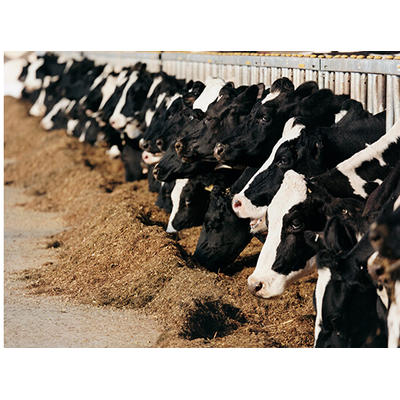


Delacon - Model Actifor Pro - Reduce Feed
Feed efficiency in both large and small ruminant livestock production is a production priority challenging producers, nutritionists, and scientists all over the world. The rising global population comes with an increasing demand for food, especially protein sources such as meat and milk. In recent years the consumption of dairy products alone has increased by more than 2.5% per year globally. The constantly increasing need for animal protein is driving the livestock feed and production industry to provide increasingly efficient, residue-free, sustainable solutions.
Therefore, higher quality and quantity of milk must be produced from the available resources. Higher ruminant energy and protein efficiency are necessary to reach the goal of more milk and meat from the amount of inputs.
A cow that produces approximately 8 gallons of milk a day with 3.3% crude protein (CP) allocates 2.19 pounds of protein to production. Since diets are formulated at around 16% CP for dairy, this cow will consume 7.72 pounds of protein per day. This means that less than 30% of the feed protein is used to produce milk protein. The remaining 70% of protein is used for the animal’s maintenance and metabolic losses.
Enhanced quantity of volatile fatty acids in the rumen and quantity of microbial protein and amino acids flowing to the small intestine can improve growth performance in beef cattle as well as milk yield and quality for dairy animals. However, if the protein or other nutrients supplied to the small intestine for absorption are not digested adequately, a reduction in milk yield and quality, or reduced growth performance in beef cattle can result, leading to decreased performance and loss of profitability.
In dairy rations, a consistent supply of high quality protein to the small intestine is essential for top milk yields. However, rations high in undegradable (bypass) protein are often very expensive and if the amount of degradable protein in the ration is not balanced with energy sources, a substantial part of the protein cannot be utilized by the ruminal bacteria leading to an excess of ammonia production. This ammonia, is then converted to urea in the liver, an energy consuming process. Part of this urea is recycled by the animal, but a larger part is excreted either through the milk or the urine.
This situation can lead to high losses of dietary protein, reduced performance, and increased feed costs. When more expensive undegradable protein sources are utilized in ruminant rations, optimizing digestion and absorption is critical for capturing the benefits from the higher input costs.
The metabolic process to reduce the excess urea in the rumen consumes the majority of feed energy. In the long term, this can reduce milk and reproductive performance.
One method to improve protein utilization is by protecting some sources of protein from microbial fermentation in the rumen to increase the amount of bypass protein available to the small intestine for absorption. Another, less expensive method, is to promote the complete and consistent breakdown of less expensive protein sources in the rumen. Providing a balanced protein and energy supply to the small intestine can improve metabolic efficiency. Thus, advantages in feed costs could be attained by decreasing input costs of by-pass protein sources and using sources rich in ruminal degradable protein.
Actifor™ Boost – for dairy and beef cattle production- Optimizes feed intake and thus supports milk yield and milk protein content, as measured in field trials through parameters like milk production, milk solids, and milk urea
- Promotes feed intake and supports energy supply for milk production
- Supports feed intake and supports protein utilization and energy uptake in the ruminant digestive system, as observed in trials
